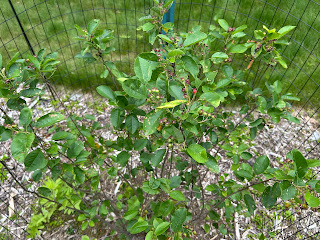This native garden that we started in the spring of 2024 is doing well, with just a few exceptions, in its second year. In 2023, we put down cardboard and composted wood chips in a rough square along the edge of the backyard turf. It receives direct sun in the morning into the midday with filtered light through the rest of the day. A wet area at the edge of the woods that had started to be infiltrated by the Japanese knotweed lies behind and to the west of it. We planted three spicebush starts in that wet area behind this garden this past spring. Renee also planted five Canada anemones, Anemone canadensis, in this wet area behind this garden this summer. As it is a robust native spreading ground cover, we are hoping that it gets established and does its part to combat the return of the knotweed here in the west of our property.
The star of the "backyard native garden" so far is the false sunflower, Heliopsis helianthoides. It has an extended bloom time, from early summer until first frost. It is not fussy, and is thriving in this garden. It is often described as a short lived perennial, so we may want to collect seeds. Some birds like its seeds, so it is one to leave without cutting back in the fall. Another feature is that the deer and groundhog population appear to leave it alone, unlike some other plants in this garden. In addition to being easy to grow and thriving in this location, it is pollinator friendly. In this photo, Renee recently caught a swallowtail visiting our false sunflower.Loooking at this photo of the other (north) side of the garden, one can see some of our attempts to include flowering plants with a variety of bloom times. The plant in the foreground of this photo is eastern bluestar, Amsonia tabernaemontana. It appears to thrive here in this location, and as a member of the Dogbane family, it has not been browsed upon. It flowers in the spring. Another early bloomer is the columbine, Aquilegia canadensis, which got started in this garden after Renee tossed in some spent flower heads from another location last year. Barely visible behind the figwort and false sunflower is one of our couple of boneset, Eupatorium perfoliatum. Now, in late August, it is not yet blooming, but it should soon.
































